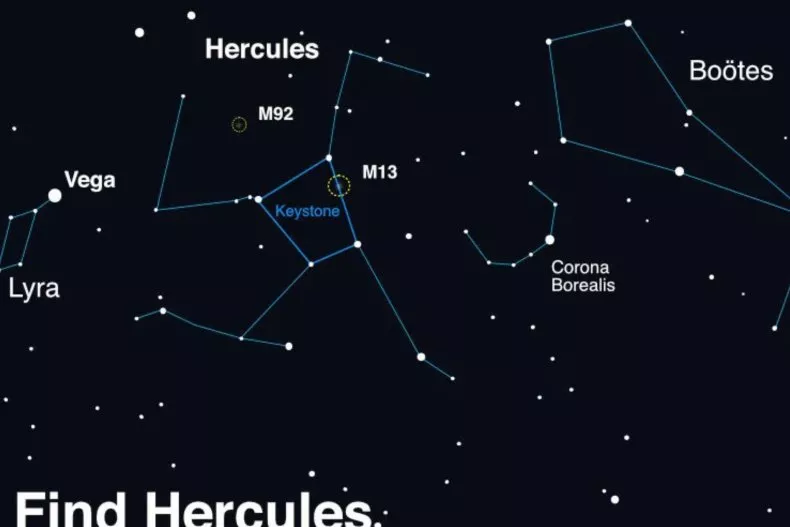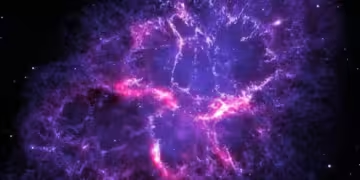A “zombie star” named T Coronae Borealis (T CrB) is set to make a spectacular comeback in the night sky, creating an eagerly awaited celestial event that’s been anticipated by astronomers for decades. Located 3,000 light-years away in the constellation Corona Borealis, T CrB is expected to go nova, becoming visible to the naked eye as it shines in a burst of brightness, much like it did during its last outburst in 1946.
What Is a Zombie Star?
T CrB isn’t a typical star. Often called the “Blaze Star,” it’s part of a binary system where a white dwarf orbits closely with a red giant. The white dwarf, a stellar remnant that has exhausted its nuclear fuel, is surrounded by a dense shell of material.
Its partner, the red giant, is an aging star that has expanded in size as it nears the end of its life. Together, they form an unusual pair: the white dwarf slowly siphons material from its companion, accumulating it until the pressure and temperature rise enough to ignite a nova explosion. This relationship creates a cycle where the white dwarf “feeds” off its partner, building up until it eventually blows off its outer layer in a flash of light.
The Life Cycle of T CrB’s Explosions
Unlike a supernova, where a massive star’s explosion leads to its ultimate destruction, a nova is more of a temporary rebirth. The white dwarf remains intact, shedding just the outer layer it gained from its companion, and then begins the process anew.
T CrB’s cycle, repeating roughly every 80 years, places it among only five other known stars with similar patterns, making it a significant object of study. For astronomers, each nova provides valuable insight into the life cycles of stars, especially in binary systems where two very different stars interact in such a dynamic way.
Anticipating the Next Outburst
While T CrB is currently unpredictable, with scientists unsure of exactly when it will erupt, recent observations indicate it’s showing similar behavior to previous nova events, making its explosion potentially imminent.
This is important because accurately predicting nova explosions is notoriously difficult, even in stars like T CrB that have relatively regular cycles. Recent fluctuations in T CrB’s brightness suggest that it could be nearing the ignition point, giving astronomers an opportunity to capture and study this phenomenon in real-time.
Why Novae Are Crucial to Science
A nova, though less dramatic than a supernova, is a thrilling event for astronomers. Each eruption provides critical data, allowing scientists to observe energy release, brightness variations, and the physical characteristics of the material being ejected. In this case, T CrB acts as a “laboratory” for understanding the thermonuclear processes that occur on white dwarfs.
This data is incredibly useful, helping astronomers refine their models on stellar behavior, particularly in systems where material exchange occurs between two stars. Observing a nova in action offers clues to stellar mechanics that have applications far beyond T CrB alone, potentially informing theories about other stellar explosions, including supernovae.
The Difference Between a Nova and a Supernova
When it comes to defining types of stellar explosions, understanding the difference between a nova and a supernova is essential. Unlike supernovae, which occur in massive stars and result in their complete destruction, novae are recurring events limited to binary systems involving white dwarfs.
In T CrB’s case, the nova is triggered when the white dwarf’s accumulated layer of hydrogen undergoes fusion, releasing energy in a luminous burst. This process can happen multiple times as long as the white dwarf and red giant continue their cosmic dance.
A Window into Cosmic Processes
Witnessing T CrB’s nova up close also provides a window into broader cosmic processes. As novae expel layers of material, they contribute elements like carbon and oxygen to the interstellar medium, enriching the galaxy’s composition and playing a role in the life cycles of future stars. These eruptions also offer clues about potential Type Ia supernovae, which occur in similar binary systems where white dwarfs accumulate material from companions.
How to See the Zombie Star’s Return
Spotting T Coronae Borealis (T CrB) during its dramatic outburst promises to be a highlight for stargazers. Since the nova will reach visibility levels bright enough for the naked eye, all you need are clear skies and a bit of preparation. Here’s how you can make the most of this cosmic spectacle:
- Timing and Anticipation
While scientists expect the explosion to happen within the next few years, the exact timing remains elusive. Keep an eye on astronomy news and updates from observatories like NASA, local stargazing clubs, and our news as experts will likely announce predictions of an imminent outburst. Such alerts are your cue to get ready! - Ideal Viewing Location
For the best view, you’ll want to be somewhere with minimal light pollution. Look for a dark-sky location away from city lights—this could be a rural area or a dedicated dark-sky park. Light pollution will dilute the brightness of T CrB, so choose your spot wisely. - Position in the Night Sky
The star will appear in the constellation Corona Borealis, known as the Northern Crown, which is a horseshoe-shaped cluster of stars situated to the west of Hercules. Corona Borealis is visible from the Northern Hemisphere, making it accessible for viewers across North America, Europe, and parts of Asia.- Using a Star Chart: To find T CrB in Corona Borealis, download a star chart or use a stargazing app. These tools will help you locate the star precisely and track the constellation’s position throughout the night.
- Best Time for Viewing: Corona Borealis is visible during different seasons depending on your location, so check which months offer the clearest view from your region. During its peak brightness, T CrB may appear as bright as a familiar star like Polaris or even brighter, depending on the magnitude it reaches.
- Viewing Equipment
While T CrB’s brightness will allow it to be seen with the naked eye during the nova, binoculars or a telescope will enhance your experience. Binoculars with a wide field of view can help you pick out details, while a telescope will reveal the intensity and color variations more vividly. - Photography and Documentation
If you’re interested in capturing this rare event, prepare your equipment in advance. With a camera and a sturdy tripod, you can capture long-exposure shots of the night sky that may reveal more of the constellation around T CrB. Set up your camera to capture several exposures, as this will allow you to document the changes in brightness and appearance over time. - Join Stargazing Events or Groups
Many astronomy clubs and observatories host stargazing events for significant cosmic phenomena like this one. Such gatherings offer a chance to view T CrB alongside experts and other enthusiasts who can share insights and equipment, enhancing your experience.

Whether you’re an amateur stargazer or an experienced astronomer, witnessing T CrB’s outburst is a unique opportunity to see a once-in-a-lifetime stellar event. Keep your eyes on the sky and enjoy this remarkable spectacle as a “zombie star” comes back to life!
Cosmic Cycles of Death and Renewal
Observing T CrB’s return isn’t only about marveling at the cosmos; it also provides a profound reminder of the universe’s cycles of creation and transformation. Each nova tells a story of life and death, illustrating the processes that have shaped the elements in our own solar system.
The explosion is a temporary yet powerful burst of energy—a fitting analogy for the life of a star that, though technically “dead,” continues to produce light and contribute to the galaxy’s growth through its interactions with a companion.
Awaiting T CrB’s Spectacular Comeback
As T CrB approaches its next eruption, it serves as a reminder that even in the vast reaches of space, cycles of death and renewal persist. For astronomers, the Blaze Star is a natural laboratory where the mechanics of stellar explosions can be observed and analyzed. For everyone else, it’s an inspiring spectacle, a rare chance to see a “zombie star” come back to life in a display of cosmic wonder that few generations get to witness. While we await the next eruption, T CrB stands as a symbol of the resilience and mystery of the universe—a universe where, even among the stars, some things are too stubborn to stay dead.
Reference:
NASA. (2024, October 31). NASA, global astronomers await rare nova explosion. NASA. https://www.nasa.gov/centers-and-facilities/marshall/nasa-global-astronomers-await-rare-nova-explosion



















